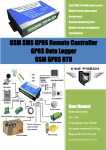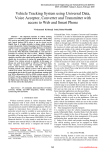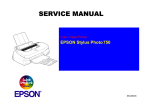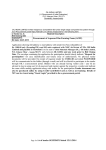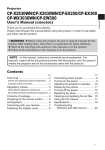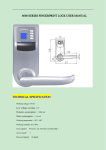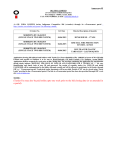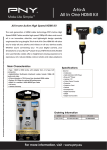Download GSM GPRS Remote Controller GPRS Data Logger GSM
Transcript
¡ Tu Sitio de Automatización ! Remote Monitoring Your Assets In Anywhere and Anytime! GSM GPRS Remote Controller GPRS Data Logger GSM GPRS RTU LBS31200 LBS31220 LBS31240 User Manual Ver 1.20 Page 1 of 1 Date Issued: 2011-08-20 Table of contents 1. Brief introduction ------------------------------------------------------------------------------------------------------------------4 2. Safety Directions -------------------------------------------------------------------------------------------------------------------6 3. Standard Packing list -------------------------------------------------------------------------------------------------------------7 4. Physical Layout --------------------------------------------------------------------------------------------------------------------7 5. Features& Specifications ------------------------------------------------------------------------------------------------------11 5.1 Features------------------------------------------------------------------------------------------------------------------------11 5.2 Specifications-----------------------------------------------------------------------------------------------------------------12 6. Settings ---------------------------------------------------------------------------------------------------------------------------13 6.1 Configuration the Basic Communication Parameters--------------------------------------------------------------13 6.1.1 Install the Driver and PC Configurator-------------------------------------------------------------------------------13 6.1.2 Configuration the GSM GPRS Remote Controller Parameters by SMS Commands----------------------16 6.1.3 Configuration/Test/Real-Time monitoring the GSM GPRS Remote Controller by GPRS ----------------17 6.1.3.1 Setup Server Parameters in Local Area Network----------------------------------------------------------------17 6.1.3.2 Configuration Server and GPRS Parameters by PC Configurator-------------------------------------------22 6.1.3.3 Access the GSM GPRS Remote Controller parameters remotely by GPRS. ----------------------------23 6.2 Configuration the GSM GPRS Remote Controller--------------------------------------------------------------------24 6.2.1 Communication Connection-------------------------------------------------------------------------------------------24 6.2.2 Basic Parameter Settings ------------------------------------------------------------------------------------------------19 6.2.3 I/O Port Parameter Settings – AIN Parameters----------------------------------------------------------------------26 6.2.4 I/O Port Parameter Settings – DIN(Counter) Parameters------------------------------------------------------28 6.2.5 I/O Port Parameter Settings – DOUT Relay Parameters-------------------------------------------------------28 6.2.6 I/O Port Parameter Settings – RS232 and RS485(Modbus RTU) Parameters----------------------------29 6.2.7 Programmable InterLock Settings – Programmable InterLock Parameters--------------------------------30 6.2.8 Programmable InterLock Settings – Timer InterLock Parameters--------------------------------------------31 6.2.9 Programmable InterLock Settings – Telephone InterLock Parameters--------------------------------------31 6.2.10 Data Logger – Monitoring Current Value--------------------------------------------------------------------------32 6.2.11 Data Logger – Historical Data Records----------------------------------------------------------------------------32 6.2.12 Data Tunneling ---------------------------------------------------------------------------------------------------------33 6.2.13 Help------------------------------------------------------------------------------------------------------------------------33 7. Installation ------------------------------------------------------------------------------------------------------------------------34 8. GPRS Protocol and SMS Command List--------------------------------------------------------------------------------36 8.1 SMS Commdands for Basic Parameters--------------------------------------------------------------------------------37 8.2 SMS Commdands for Server and GPRS Communication Parameters-----------------------------------------37 8.3 SMS Commands for Digital Input Parameters-------------------------------------------------------------------------40 8.4 SMS Commands for Output Relay Parameters-----------------------------------------------------------------------41 8.5 SMS Commands for Interlock and Pulse Counter Alarm Parameters-------------------------------------------42 8.6 SMS Commands for Timer Parameters--------------------------------------------------------------------------------44 8.7 SMS Commands for Setup Authorized Numbers and Relay Output Response Parameters--------------45 8.8 SMS Commands for Analog Input Parameters -----------------------------------------------------------------------45 8.9 SMS Commands for RS485 Port Parameters-------------------------------------------------------------------------48 8.10 SMS Commands for Inquiry Real Time Data Parameters-------------------------------------------------------50 9. Monitoring Center or OPC Server or SCADA ------------------------------------------------------------------------51 9.1 Directly to SCADA System-----------------------------------------------------------------------------------------------51 9.2 Monitoring by SCADA System through OPC Server--------------------------------------------------------------52 9.3 By customer customization monitoring center----------------------------------------------------------------------53 Page 2 of 2 9.4 By Mobile phone through SMS-----------------------------------------------------------------------------------------54 9.5 Real-Time monitoring by PC Configurator---------------------------------------------------------------------------54 10. Upgrade Firmware Warranty ------------------------------------------------------------------------------------------------54 11. Warranty -------------------------------------------------------------------------------------------------------------------------54 Model Table Model AIN DIN DOUT Temp. USB RS232 RS485 LBS31200 4 2 2 2 1 0 1 LBS31220 6 6 4 2 1 0 1 LBS31240 10 6 4 2 1 0 1 More applications please see LBS31240 This handbook has been designed as a guide to the installation and operation of LBS312xx Series GSM GPRS Remote Controller. Statements contained in the handbook are general guidelines only and in no way are designed to supersede the instructions contained with other products. We recommend that the advice of a registered electrician be sought before any Installation work commences. Logicbus, its employees and distributors, accept no liability for any loss or damage including consequential damage due to reliance on any material contained in this handbook. Logicbus, its employees and distributors, accept no liability for GSM Network upgrading or SIMCard upgrading due to the technology specifications contained in this handbook. Page 3 of 3 1. Brief introduction The LBS312XX Serial GSM GPRS Remote Controller is a universal GSM dialer and controller as well as a GSM GPRS Remote Control and Alarm Unit. it provides multi digital relay outputs(120VAC/3A, 24VDC 3A,), upto 6 digital inputs(Opto-isolated,Active Contact, 3~24VDC, Completely isolated).can be used as pulse counter inputs), 2 temperature inputs for DS18B20, multi analog input(both of 0-20mA and 0-5V, 12 bit resolution), RS485 Port(Support Modbus RTU Protocol, more protocols can be added according to application requirements), reserved RS232 Serial Port and USB port for setting and download upgraded firmware by user on-site. It allows you to monitor and control an alarm or remote stations or equipments or machines by SMS(Short Message Service) Or GPRS. Another, it can transmit data from apparatus (thermometer, humidity meter, electric meter, flowmeter, PLC) to user or monitoring center by GPRS. The LBS312XX Serial GSM/GPRS Remote Controller equipped Siemens MC55i quad-band GSM Module inside to make it is industrial class reliability, is a low cost, wireless M2M, wireless data logger, universal GSM GPRS Engine which can remote control outputs, transmit and receive analog, digital and pulse counter data, PLC, Varity metering equipments to any device connected to the Wireless GSM GPRS network such as mobile phones, Web Sites, monitoring center, control room, SCADA, etc. The GSM GPRS Remote Controller LBS312XX can be used as: • A Switch with SMS Remote Control. SMS texts for switching particular terminals on/off are configurable. • A Timer-Switch which can be activated automatically. It can be used as preset time when the GSM GPRS Remote Controller need work and when it needn‘t work. 4 daily timer and 7 Weekly Timers. • A Relay with dialling-in remote control. Up to 4 tel. numbers can be authorized for it. Because calls are not answered dialling-in control within GSM is free of charge. (it only checks the caller’s number and - if the number is authorized - responds with relay activation.) This can be used for parking latch control, gsm gate opener, remote control machine, etc. • An automation system. Each input can link to output actions, this is very useful when the temperature upto appointed value, need switch on the air-conditioning immediately, or when water overflow and need switch on the dryer, or when somebody broken into the door or windows need to start the CCTV and Siren. • A SMS reporter. The digital Inputs activations or deactivations can be reported by SMS and optionally confirmed by phone calls. Each input can have its own message texts and the message can be programmed by users. • A Pulse Counter. The digital inputs can be used as the pulse counter, the user can setup both of interval value activated alarm and total value activated alarm. Page 4 of 4 • A Data Logger. The unit can save the all of the acquisition data in internal memory storage and upload to internet by GPRS network according to schedue, no distance limitation. • A Wireless Data Acquisition to SCADA or HMI or Monitoring Center. The unit can acquisition the varity data(E.g.: Pressure, Level, Current, Voltage, digital input status, pulse counter, digital relay output status, temperature value, humidity value and other) and upload to the SCADA(Real time dynamic data) or HMI or Mornitoring Center by SMS or GPRS, no distance limitation. • A Wireless Intelligent Meter Reader. The GSM GPRS Remote Controller can be used to read remotely intelligent meter data to SCADA or monitoring center by RS232 port or RS485 Port, at present supports ABB,KL,HHE intelligent meters by RS485, more special meters’ communication protocol can be add according to application requirements. • A GSM GPRS Remote Termials (GSM GSM GPRS Remote Controller). It can work with the supervisioning center, in the supervisioning center, the own can remote monitoring and control the remotely terminals by GSM GPRS Network.This is very useful to Fuel tank monitoring, Oxygen in hospital, Flood level, street light control, wellhead control, BTS environment monitoring, power transmission system monitoring and other applications. What Applications does the GSM GPRS Remote Controller suitable for? Page 5 of 5 1. Security Alarm System applications; 2. Supervision and monitoring alarm systems 3. Automatic monitoring system; 4. Vending Machines; 5. Pumping Stations; 6. Buildings and Real Estate; 7. Weather Stations remote control and data logging; 8. River Monitoring and Flood Control remote control and data logging; 9. Oil and gas pipelines remote control and data logging; 10. Corrosion protection 11. Valve controls; 12. Wellheads; 13. Energy saving,street lights control system; 14. Tanks, levels, temperatures,water leakage applications; 15. Transformer stations; 16. Unmanned machine rooms; 17. Control room application; 18. PLC and Automation System, M2M; 19. GSM Access Control System, GSM Gate Opener, etc. 2.Safety Directions Safe Startup Do not use GSM GPRS Remote Controller when using GSM equipment is prohibited or might bring disturbance or danger. Interference All wireless equipment might interfere network signals of GSM GPRS Remote Controller and influence its performance. Avoid Use at Gas Station Do not use GSM GPRS Remote Controller at a gas station. Power off GSM GPRS Remote Controller when it near fuels or chemicals. Power it off near Blasting Places Please follow relevant restrictive regulations. Avoid using the device in blasting places. Reasonable Use Please install the product at suitable places as described in the product documentation. Avoid signal shielded by covering the mainframe. Use Qualified Maintenance Service Maintenance can be carried out only by qualified maintainer. Page 6 of 6 3. Standard Packing List GSM GPRS Remote Controller 12V Adaptor GSM antenna USB cable CD(User Manual and PC Configurator) 4. Physical Layout 4.1 Control Unit physical layout LED Instruction Power The Power status indicator, when power on the LED will turn normally on. GPRS Satus GPRS Module indicator, GPRS Connective successful will slowly flick. Transmitting GPRS Transmitting data out is on, otherwise is off. Receiving GPRS Receiving data is on, otherwise is off. Page 7 of 7 Alarming Alarm Indicator, on is alarming, off is normally; Relay Relay status, when relay acting is on, otherwise is off; RS232 RS232 Port communication indicator, normally is off; RS485 RS485 Port communication indicator, normally is off; Interface 1 Instruction Upgrade Button Download This Button(Nearby SIMCard) is for download the firmware, the user no need to use it. Press the button then switch on the panel, after 3S loose the button. Then update the firmware through the USB cable from computer. Reset Button Reset This is the reset button(Nearby SIMCard), Press the button then switch on the panel, after 3S loose the button. After reset, only the passwords will recovery to defaults. The Inquiry password is: 0000, the Administrator Password is 1111. The user can use these passwords to inquiry and control the GSM GPRS Remote Controller by mobile phones. Interface 2 Instruction Power Connector Definition Page 8 of 8 BATSW Internal Backup battery Switch, these two point is the backup battery switch, normally, must short contact them to switch on the backup battery. If long time no use the unit, please disconnect them to save the battery, otherwise, when the backup battery turn over, it will BATSW cannot be re-charged any more. See below: DC IN+ External Power Connector, Connect to 1.5A@12V DC power through AC/DC Adaptor, positive electrode. DC IN- External Power Connector, negative electrode. Digital Relay Output Connector Definition DO4+ Digital Relay Output 4+, positive electrode, this output can be programmed as NC or NO; DO4- Digital Relay Output 4-, negative electrode, this output can be programmed as NC or NO; DO3+ Digital Relay Output 3+, positive electrode, this output is only NO type; DO3- Digital Relay Output 3-, negative electrode, this output is only NO type; DO2+ Digital Relay Output 2+, positive electrode, this output can be programmed as NC or NO; DO2- Digital Relay Output 2-, negative electrode, this output can be programmed as NC or NO; DO1+ Digital Relay Output 1+, positive electrode, this output is only NO type; DO1- Digital Relay Output 1-, negative electrode, this output is only NO type. COM Port Connector Definition 485A 485A 485B 485B RST RST(RS232 CONTORL) TXD TXD(RS232) RXT RXD(RS232) GND GND USB Port Connector Definition USB USB port, for configuration the GSM GSM GPRS Remote Controller. ATN Port Connector Definition ATN GSM Antenna connector, 50Ohm, SMA female. Interface 3 Instruction Page 9 of 9 Analog Input Connector Definition DC3.3V +3.3VDC@400mA power output for external device (Fuse inside). GND GND AIN1+ Analog input 1, positive electrode. AIN2+ Analog input 2, positive electrode. AIN3+ Analog input 3, positive electrode. AIN4+ Analog input 4, positive electrode. GND GND AIN5+ Analog input 5, positive electrode. AIN6+ Analog input 6, positive electrode. AIN7+ Analog input 7, positive electrode. AIN8+ Analog input 8, positive electrode. GND GND AIN9+ Analog input 9, positive electrode. AIN10+ Analog input 10, positive electrode. Digital Input Connector Definition DC12V +12VDC@750mA power output for external device (Fuse inside). DIN1- Opto-isolated digital input1, negative electrode (Active Contact, 3~24VDC, Completely isolated). DIN1+ Opto-isolated digital input 1, positive electrode. DIN2- Opto-isolated digital input 2, negative electrode (Active Contact, 3~24VDC, Completely isolated). DIN2+ Opto-isolated digital input 2, positive electrode. GND GND DIN3+ Opto-isolated digital input 3(Active Contact, 3~24VDC). DIN4+ Opto-isolated digital input 4(Active Contact, 3~24VDC). DIN5+ Opto-isolated digital input 5(Active Contact, 3~24VDC). Page 10 of 10 Opto-isolated digital input 6(Active Contact, 3~24VDC). DIN6+ Temperature Connector Definition (For Temperature Meter DS18B20) DC3.3V +3.3VDC@400mA power output for external device (Fuse inside). AIN11+ Temperature Meter DS18B20 Input GND GND DC3.3V +3.3VDC@400mA power output for external device (Fuse inside). AIN12+ Temperature Meter DS18B20 Input GND GND 5. Features& Specifications of GSM GPRS Remote Controller: RS-232 Interface Relay output Analog/Digital inputs Watchdog RS-485 Interface STM Industrial MCU GSM/GPRS Engine Power management Battery Audio management USB Interface Temperature Sensor DC Input 5.1 Features 1) Quad-band Siemens MC55i GPRS Module and High-density performance line ARM 32-bit MCU inside; 2) Direct connection to the GSM GPRS Network; 3) Transparent Serial Data Tunneling using low cost SMS/GPRS network; 4) Remote Configuration by SMS Messages or GPRS; 5) Upload data via GPRS or SMS on Schedule or event occurs; 6) Supports Dynamic Domain name or Static IP address; 7) Supports SMS, GPRS UDP and TCP protocols; 8) Supports Modbus RTU protocols; Page 11 of 11 9) 1USB Port, 1 RS232 Serial Port, and 1 RS485 Serial Port; 10) 6 Opto-isolated digital inputs can be programmed to NC/NO/Edge/Level type by switch, Passive Contact Type and Active Contact (3~24VDC) type can be programmed by DIP switch, DIN1 and DIN2 are Completely isolated. when alarm occurs can send Alarm Messages by SMS or GPRS or auto dial the preset phone numbers; 11) 6 digital inputs can be used as Pulse Counters; 12) 4 Digital Relay Outputs can be programmed as dial to switch on/off with free communication fee, alarm-linkage and Schedule to action, also can be send SMS to switch on/off; 13) 10 Analog Inputs. (12 bit resolution, 0-5V or 0-20mA); 14) 2 Thermometer Inputs for DS18B20, measures temperatures from -55°C to +125°C. Fahrenheit equivalent is -67°F to +257°F, ±0.5°C accuracy from -10°C to +85°C, Thermometer resolution is programmable from 9 to 12 bits; 15) 4 Power Source Outputs for external device, like Thermometer or transducer, 3 with 3.3V/400mA, another with 12VDC/750mA; 16) Supports 1 SMS Center Number and 1 IP address or 1 Dynamic Domain name; 17) User friendly PC Programming Interface, it can remotely program the terminals as well as to upload the data from the terminals by SMS or GPRS, all of the Current Value or status of the terminal can be display directly, and also will display the SMS Command details while you programming it; 18) More Protocols can be updated by user through USB Port with the updated firmware; 19) Power supply 9V to 24V(Recommend 12VDC); 20) Size: 168mm*113mm*32.3mm. 5.2 Specifications Parameter Item DC Power supply Power consumption GPRS Module Frequency bands Transmit power GPRS connectivity GPRS Data Transmission Reference Scope Standard adapter: DC 12V/1.5A Standby:12V/70mA; Working Max.: 12V/300mA Siemens MC55i Quad-band: EGSM 850,EGSM900, GSM 1800, GSM 1900, Compliant to GSM Phase 2/2+ Class 4 (2W) at EGSM 900 and EGSM 850 Class 1 (1W) at GSM 1800 and GSM 1900 GPRS multi-slot class 10 GPRS data downlink transfer: max. 85.6 kbps GPRS data uplink transfer: max. 42.8 kbps Coding scheme: CS-1, CS-2, CS-3 and CS-4 TCP/IP stack TCP,UDP SIM interface Supporting 3V SIM Card External antenna Page 12 of 12 Reference scope 9-24V DC Connected via 50 Ohm antenna connector or antenna pad, SMA Antenna interface Serial Interfaces Protocols 1 RS-232 Port,1 RS485 Port, 1 USB Port; SMS, GPRS UDP,TCP, Modbus RTU, and more equipment protocols can be added according to requirements. Digital Inputs 6 OPT Coupler (3-24V) NC/NO/Edge/Level type Active Contact and Passive Contact By Switch Can be used as Pulse Counters; Analog Inputs 10 Analog Inputs. 12 bit resolution, 0-5V or 0-20mA; Thermometer Inputs 2 Ports DS18B20. Measures temperatures from -55°C to +125°C. Fahrenheit equivalent is -67°F to +257°F, ±0.5°C accuracy from -10°C to +85°C, Thermometer resolution is programmable from 9 to 12 bits. Digital Relay Outputs 4, 120VAC/3A, 24VDC 3A, Can be controlled by Event, scheme, Incoming call, SMS Commands, Timer, Interlock, 2 outputs can setup as NC or NO type; Power Source Outputs Memory Capacity Internal Backup Battery Temperature range Humidity range Exterior dimension Net Weight 3 Ports with 3.3VDC/400mA Power for external device; 1 Port with 12VDC/750mA Power for external device; 4MB Memory inside, can save the data for 1 month. 7.4V 1200mAH -10-+70 °C Relative humidity 95% (condensation free) 168mm*113mm*32.3mm 1000 g 6. Settings The GSM GPRS Remote Controller is for user-friendly design. The user can setup it by the PC Configurator through USB cable. The GSM GPRS Remote Controller also can be configured parameters by SMS Commands or GPRS remotely. Tips! 1) Please insert the SIMCard firstly, and install the GSM Antenna, please power on to check the LEDs can work or not, then switch off it before you program it by PC Configurator. 2) The PC Configurator in the CD, please click it to run it. The PC configurator can be used for local configuration the GSM GPRS Remote Controller by USB, also can be used for remotely configuring the unit and remotely real-time monitoring the data and status. 3) The PC Configurator can not display all pages until it contacted to the GSM GPRS Remote Controller successful. 6.1 Configuration the Basic Communication Parameters 6.1.1 Install the Driver and PC Configurator Please following the below steps one by one to install them, otherwise you cannot install them successfully. Step1: Please Contact the unit to the PC by USB Cable, and then install the USB Driver to the computer from Page 13 of 13 the CD firstly. When successful, it can be found out at the device manager of the XP or Windows 7, please see the below photo. And remember the COM port. Also, the driver for different OS can be downloaded from Silicon Laboratories, Inc. http://www.silabs.com , the model is CP210x. If the Com port is not Com1~Com5, then please right click the Device, then enter the Properties to change it, see below photos, after you changed it, and please restart the computer. Page 14 of 14 Step2: Please insert the SIMCard into the GSM GPRS Remote Controller carefully; Step3: Please running the PC Configurator, needn’t installed it, but the below documents must be is the same folder. Step4: Please connect the GSM GPRS Remote Controller to the computer through USB cable, and switch on the GSM GPRS Remote Controller; Step5: Select the correctly Com Port at the Com Port, then click Open. Then click the Connect button, if it displays success, then means the GSM GPRS Remote Controller communicating with the computer now. otherwise, please check the Com port and the USB Driver. Page 15 of 15 6.1.2 Configuration/Inquiry the GSM GPRS Remote Controller Parameters by SMS Commands The user can configure or Inquiry the parameters by SMS Commands. The commands please see the Operation Commands Line in the PC Configurator or see 8. GPRS Protocol and SMS Command List。. When you click any button the commands will be display in the Operation command, this is the command for SMS and GPRS transimssion. When use the SMS Commands or GPRS to configure or inquiry the settings, please plus the password correctly that setup at the Basic Parameter page. Please use the Inquiry Password to instead of the PPPP, and use the Administrator Password to instead of SZJH#. For example: If you want to setup the Station Number as 00001, the administrator password is 1111 , and the inquiry passowrd is 0000, then please edit SMS content as 1111#BST:00001# then send to the GSM GPRS Remote Controller. Also you can send 0000#E1# from Mobile phone to inquiry the settings. Notice: 1. In some GSM operators they use different SMS protocols, if the unit can’t return the SMS confirmation is Page 16 of 16 normally. It is not product problem. Also, you can try to add the country code before the number, see the below settings: For example: In China, the country code is +86, or 0086. The user cell phone number is 13570810254 and has been assigned as a SMS Alert number, the simcard number in the panel is 13512345678. Problem 1: Alarm but the user hasn’t received the SMS Alert. Solution: Please plus the country code while you setup the 13570810254 as SMS Alert number, means setup +8613570810254 to instead of the 13570810254. Problem 2: The user number can receive the SMS Alert message from alarm panel, but the alarm panel can not receive the commands from the user number. Solution: Please add country code to the SIMCard number in the alarm panel. Means send sms commands to +8613512345678 to instead of 13512345678. Solution 3: When you use cell phone dial another one, what number it will be displayed then you can set the displayed number as dial numbers; when you use cell phone send SMS to another cell phone, what number it will be displayed then you can set the displayed number as SMS Alert number, just use the “+” to replace the “00”, also, you can try the “00”. 6.1.3 Configuration/Test/Real-Time monitoring the GSM GPRS Remote Controller by GPRS remotely The GSM GPRS Remote Controller supports GPRS Communication to the Server, it is useful to create the multipoint data logging center or remote control. If you need the GPRS Communication function, please setup GPRS Connection as Open, and setup the other Server and GPRS Parameters. if you not use GPRS to transmit the data, then setup it as close, and all of the below Server/GPRS Parameters no need to setup. Before using the GPRS function, please setup the GPRS parameters by PC Confirgurator or by SMS commands firstly. The SMS Commands please refer to 8. GPRS Protocol and SMS Command List. If you have Server for the GSM GPRS Remote Controllers, you will have a static IP address or DNS. So that all of the GSM GPRS Remote Controllers can transmit the data to this server. Also, you have the Port for the GSM GPRS Remote Controllers. So just setup the Server DNS or Server IP address,Server Port and GPRS Parameters. Please directly to the 6.1.3.2 Configuration Server and GPRS Parameters by PC Configurator 6.1.3.1 Setup Server Parameters in Local Area Network If you use Local Area Network + Router + ADSL, and want to test the GPRS communication function and remotely monitoring real-time data of the GSM GPRS Remote Controller, so you can use the local area network computer as the server, but must setup the router forwarding function, also, once the router restart, the IP address will be change, so please ensure the Router will not disconnect internet. please see below instructions. Page 17 of 17 1) Find Out Server IP Address and Port ※ Enter into the Router,at the IE address enter 192.168.1.1(Please ask the routers’ manufactuer for the Router’s IP address.) then will pop up the below dialog. Enter the user name and password, then you can enter into the router setting. ※ Find out WAN IP Address Click the Status, then you can see the WAN IP Address, and then write down this IP Address. Abovementioned is 183.13.236.205. ※ Setup Forwarding the data to Local Computer by Port. Click the Forwarding button, will display the below page, please fill the Port Number, and tick Protocol TCP to enable TCP protocol, fill the IP address(This IP address is Page 18 of 18 Local Computer IP address), and tick the enable. Then click the Apply button to save it. ※ Setup Dynamic Routing Please go to the Dynamic Routing, setup the start IP from 192.168.1.3 to end IP address 192.168.1.254. and enable the State to enable the DHCP. see below. Means the local computer’s IP address must be included in the Start IP and End IP. Click OK, ※ Setup Local Computer IP Address Click the internet connection, see below: Page 19 of 19 will pop up the below dialog: Click the Property Button to enter the Local Network setting. Will pop up the below dialog. Page 20 of 20 Click the Internet Protocol(TCP/IP), then click the R. will pop up the below dialog. Enter the Local Computer IP address that you setup in the Router Forwarding. Abovementioned is 192.168.1.107. . Till now, you can use the Local Computer as the Server. The server parameters setup finished, please Page 21 of 21 remember the parameters, e.g.: abovementioned parameters are below: Server IP Address: 183.13.236.205 Protocol: TCP Local Computer IP address: 192.168.1.107 Port: 4662 6.1.3.2 Configuration Server and GPRS Parameters by PC Configurator 1) Successfully connect the communication between RTU LBS31240 and computer, refer to 6.1 Install the Driver and PC Configurator step5. 2) Click the Basic Parameter Settings in the PC Configurator. See the Server and GPRS Parameter Settings. Tips: Please help to ensure the Set Success! Alerting in the Received Data after you click the Save button, otherwise, means the setting is failure. a) Setup the GPRS Communication as Open, if setup as Close, then means not use GPRS for data communication, and no need to setup the below items. b) Setup the GPRS Data Transmit Interval Time as 5minutes or 10minutes. c) Setup the Server DNS, this is the Server Domain, the format is www.xxxx.xxx, if not use DNS, then please keep it blank. (Notice: the GSM GPRS Remote Controller only support one Server, if you use DNS, then cannot fill the Server IP address, if you use Server IP address, then cannot fill the DNS.) d) Setup the Server IP Address, this IP Address is Server IP Address, abovementioned is 183.13.236.205. e) Setup the Server Port, means the router get the data will forward to this port, abovementioned port is 4662. f) Setup the APN, the APN is GPRS Access Point Name, provided by GSM Operator. g) Setup the GPRS Protocol, this is to setup which protocol would you like to use it for transmitting the data by GPRS. Please select TCP. if you want to use the PC Configurator for remotely setup the GSM GPRS Remote Controller, or test the GPRS communication, or remotely real-time monitoring the GSM GPRS Remote Controller. Must setup the GPRS Protocol as TCP. h) Heartbeat Period: only when you setup as UDP protocol, need to fill it, you can fill it from 1~100S, recommend value is 10. If you setup as TCP Protocol, then no need to fill the Heartbeat Period. Page 22 of 22 i) Setup GPRS Re-Connection Interval Time: the interval time to reconnect the GPRS channel once it failure. Unit is second, Max. 4 digits. j) PIN Code: SIMCard PIN Code, if the SIMCard with PIN code, then please fill it. Otherwise, keep it blank. k) User name and password to access internet: according to the GSM Operator, if they require, then please fill it, otherwise, please select Disable. l) User Name: Provided by GSM Operator. m) Password: Provided by GSM Operator. Till now, you finished the Server and GPRS Parameter settings, please disconnect the GSM GPRS Remote Controller, insert the SIMCard and restart it. Then you can remotely access it by the local computer now. see 6.1.3.3. 6.1.3.3 Access the GSM GPRS Remote Controller parameters remotely by GPRS. After you setup the basically GPRS Parameters of the GSM GPRS Remote Controller LBS31240 by local USB or SMS commands, then you can remotely setup the other parameters or monitoring real-time values of the GSM GPRS Remote Controller LBS31240 on site. Running the GSM GPRS Remote Controller PC Configurator in Local Computer that you setup as server(The Local Computer is the one that you fixed the IP Address, as abovementioned is 192.168.1.107), see below: Select the IP Communication at the Choose Communications, at the Server IP then select this computer IP address(as abovementioned is 192.168.1.107, please note, the Local Computer was set as the Server, so here the Server IP Address should be Local Computer IP Address.), and fill its IP Port(as abovementioned the port of the TCP Protocol is 4662 ), and then click the Establish Connection Button. Page 23 of 23 Please wait 1-120seconds for the GPRS communication. When the computer received the GSM GPRS Remote Controller data return back, will display all of the GSM GPRS Remote Controller ’s IP Address and their Ports at the Client IP and Port Status that connected to this server, choose one of the displayed IP and Port, the IP address and Port of LBS31240 will automatically display at Target IP and IP Port, then click the Connect button to create the communication of this unit, meanwhile,in the Received Data will display Connection Success. Then you can configure the other parameters or monitoring the GSM GPRS Remote Controller by this computer. 6.2 Configuration the GSM GPRS Remote Controller 6.2.1 Communication Connection After you connect the GSM GPRS Remote Controller to computer, then you can start to configure the parameters. 1) 2) 3) 4) 5) 6) Query GPRS Modules Status: Click the Query GPRS Modules Status button, the GPRS Module status will be displayed; Reset: Click it to reset the parameters to the factory defaults; Read Settings: Click it to read the present parameters in the GSM GPRS Remote Controller; Save Settings: Click it to save the present settings to GSM GPRS Remote Controller; Load Profile: Load the settings from the Saved file in the computer to the PC Configurator; Save As Profile: Save the present settings as a profile and saved in the computer for future use. Notice: When you want to save the present parameter settings as a profile from the GSM GPRS Remote Controller to the computer, please fill the profile name in the Profile Name, and click Read Settings to read the parameters to the PC Configurator firstly, after finished, it will display Read Successful in Received Data, then click Save As Profile to save it. When saved it, the file name will plus the prefix STA Page 24 of 24 before the name you write, and saved under the Profile folder. When you want to Load Profile from computer to the GSM GPRS Remote Controller, please click Load Profile button, at the right side will pop up the profile list, select the correct one then click the Save Settings button, after finished, it will display Set Completion! in the received Data. It means the Profile download to the GSM GPRS Remote Controller successfully. 6.2.2 Basic Parameter Settings Click the Basic Parameter Settings to configure the basic parameters. Notice: Please help to ensure the Set Success! Alerting in the Received Data after you click the Save button, otherwise, means the setting is failure. 1) 2) 3) 4) 5) 6) 7) 8) 9) Station Number: To setup the Station Number, Max 5digits; Setup Inquiry Password: To setup the password for mobile phone inquiry, 4digits; Setup Administrator Password: To setup the administrator password for mobile phone setup,4digits; Setup Date Time: To setup the GSM GPRS Remote Controller time, format is: Month/Day/Year/Hour/Minute; Save Data Period: To setup time intervals to save the data into the GSM GPRS Remote Controller memory; SMS Center Number: To setup the SMS Center Number, must be SIMCard Number. This number will receive the alarm message and complete report data from GSM GPRS Remote Controller by SMS; Send SMS Period: To setup the time intervals to send complete report data to SMS Center Number; Tel NO.1-NO.6: To setup the Alarm numbers, when alarm arises, the GSM GPRS Remote Controller will dial these numbers and send Alarm messages by SMS one by one(SMS prior to Dial); Read Setting: To review the present parameter settings of the GSM GPRS Remote Controller. Page 25 of 25 6.2.3 I/O Port Parameter Settings –AIN Parameters Click the I/O Port Parameter Settings to configure the AIN parameters. Notice: Please help to ensure the Set Success! Alerting in the Received Data after you click the Save button, otherwise, means the setting is failure. AIN1-AIN10: These the Analog inputs, the analog input can be 0-5V or 0-20mA. There’re 3 Actions for selectable of each input. Ignore: Don’t care; Acquire Data: Only acquire data; Alarm and Acquire: Acquire the data from the analog input and also alarm when the value is abnormal. Measured Hi: The measured High Value, like 100 Celsius degree; Mesured Lo: The measured Low Value, like -100 Celsius degree; Start: The value to start to process the linear transformation with the equal-slope, like 0V or 1V, the value must be voltage value according to the Linear Transformation with Equal-slope Calculation Simulator. Threshold Hi: The higher value need to alarm, like 50Celsius degree; Threshold Lo: The low value need to alarm, like -50Celsius degree; An analog input gets data from a sensor device and measures a scalar value (volts, mill ampere or resistance) it than returns an integer value ranging to the GSM GPRS Remote Controller device. In order to convert the returned integer value to a proper engineering measurement value, the GSM GPRS Remote Controller use the linear transformation with the equal-slope calculation formula inside and based on 0-5V, the value at the Start must be voltage value according to the Linear Transformation with Equal-slope Calculation Simulator. Page 26 of 26 To make thing clearer, consider the following example: Example 1: Suppose a sensor, which output 0V at a temperature of -100 Celsius degree and 5V at a temperature of 100 Celsius degree, is attached to the GSM GPRS Remote Controller. And the Threshold Low Alarm value is -50 Celsius degree, the Threshold High Alarm value is 50 Celsius degree, when alarm, the Relay 2 close, and send SMS to Tel No.1, You can make the following settings: Example 2: Suppose a sensor, which output 4mA at a temperature of -100 Celsius degree and 20mA at a temperature of 100 Celsius degree is attached to the GSM GPRS Remote Controller. And the Page 27 of 27 Threshold Low Alarm value is -50 Celsius degree, the Threshold High Alarm value is 50 Celsius degree, when alarm, the Relay 2 close, and send SMS to Tel No.1, You can make the following settings: Notice: Please note the Start Value is 1 while use the 4-20mA sensor. See Linear Transformation with Equal-slope Calculation Simulator. The linear transformation with the equal-slope calculation formula based on 0-5V, the value at the Start must be voltage value according to the Linear Transformation with Equal-slope Calculation Simulator. Relay1~Relay4: To setup when the input arising alarms, the relay action; Tel No.1~No.6: To setup when the input arising alarms, the relay action; AIN11~AIN12: Special for Temperature Meter DS18B20; AC Power: This is the power voltage value after rectified voltage from the external AC Power or internal backup battery that supply to the GSM GPRS Remote Controller; Alarm Message settings: The user can select the specified analog input from the AIN Channel, and edit its alarm SMS Alert content, then click the Save Setting to configure the alarm message for each input. 6.2.4 I/O Port Parameter Settings –DIN(Counter) Parameters Click the I/O Port Parameter Settings and open the DIN(Counter) Settings to configure the DIN parameters. Notice: Please help to ensure the Set Success! Alerting in the Received Data after you click the Save button, otherwise, means the setting is failure. DIN1-DIN6: These the digital Opto-isolated inputs, the user can change the DIP switchers in the motherboard to setup each input to be Passive contact or Active contact type, default is Passive contact. If setup as Active contact type, the voltage range is 3~24VDC. The DIN1 and DIN2 are completely isolated, both of them with there’re own signal negative electrode. The signal negative electrode of them are disconnect to the Circuit board GND. The signal negative electrode of DIN3~DIN6 are connect to the circuit board GND, There’re 5 Actions for selectable of each input. Ignore: Don’t care; Page 28 of 28 Counter: For pulse counter; Close Alarm: Normally open, when close will alarm; Open Alarm: Normally close, when open will alarm; OC-CO Alarm: When the status of the input change will alarm (Rising, falling) Pulse (Counter) Alarm Value: When used the input as Counter, the user can setup the alarm value of the counter in correspondence. Alarm Message settings: The user can select the specified analog input from the AIN Channel, and edit its alarm SMS Alert content, then click the Save Setting to configure the alarm message for each input. 6.2.5 I/O Port Parameter Settings –DOUT Relay Parameters Click the I/O Port Parameter Settings and open the DOUT Relay Settings to configure the Digital Output Relay parameters. Notice: Please help to ensure the Set Success! Alerting in the Received Data after you click the Save button, otherwise, means the setting is failure. The user can setup the digital output action according to the conditions. When the relay close time setup as 0(the Max. time is 9999Seconds), then the relay will keep the close status, will not open. The user can test the relay by press the Save Button of When it be Controlled by Sending SMS Commands, and the relay close time will be the same as the settings at When it Be Controlled By Sending SMS Commands, the Relay Output Time. 6.2.6 I/O Port Parameter Settings –RS232 and RS485(Modbus RTU) Parameters Click the I/O Port Parameter Settings and open the RS232 and RS485 (Modbus RTU) Settings to configure the RS232 and RS485 (Modbus RTU) parameters. Notice: Please help to ensure the Set Success! Alerting in the Received Data after you click the Save button, otherwise, means the setting is failure. Page 29 of 29 The RS485(Modbus RTU) can read 4 Analog data and 4 pulse counter data, the RS232 can read special electric meters, Max. 2 analog data and 2 pulse data. We can add the other protocols and more analog and pulse counters values according to the requirements of the projects. The GSM GPRS Remote Controller supports Modbus RTU protocol by RS485. M_Addr: this is the modbus address of the meters; D_Addr: this is the register address of the meter. 6.2.7 Programmable InterLock Settings –Programmable InterLock Parameters Click the Programmable InterLock Settings to configure the Programmable InterLock parameters. Notice: Please help to ensure the Set Success! Alerting in the Received Data after you click the Save button, otherwise, means the setting is failure. InterLock: there’re InterLock1~InterLock4, can be setup as 4 independent interlock. if the Condition1~4 Page 30 of 30 co-occurrence, then the relay1~Relay4 will execute the actions in correspondence. If any one or more conditions of condition1~condition4 is not used as condition, then its value must be setup as True in the drop menu. Pulse Alarm(Counter, Pulse Input): To setup if the counter reach the value then how to handle it. Pulse Interval Alarm Value: To setup the value (Counter) interval to alarm; like every 5000 then alarm once; Total Alarm Value: To setup the total value, means when the counter value reach this value. Alarm Action: To setup when the total value reach the setup value, need to alarm or not. 0 stand for ingore, 1 stand for alarm. 6.2.8 Programmable InterLock Settings –Timer InterLock Parameters Click the Programmable InterLock Settings and open the Timer InterLock Settings to configure the Timer InterLock parameters. Notice: Please help to ensure the Set Success! Alerting in the Received Data after you click the Save button, otherwise, means the setting is failure. The user can setup the dialy timers and Weekly timers of the actions of the output relays. The relay close time is according to DOUT Relay Settings. 6.2.9 Programmable InterLock Settings –Telephone InterLock Parameters Click the Programmable InterLock Settings and open the Telephone InterLock Settings to configure the Telephone InterLock parameters. Notice: Please help to ensure the Set Success! Alerting in the Receive Data after you click the Save button, otherwise, means the setting is failure. Page 31 of 31 The user can setup the authorized telephone numbers to control the digital output relays. The GSM GPRS Remote Controller will verify the incoming numbers, if it is the same as the preset numbers, the GSM GPRS Remote Controller will hang up then the output relays will execute the actions. 6.2.10 Data Logger – Monitoring Current Value Click the Data Logger, the user can check all of the current value of different inputs. 6.2.11 Data Logger –Historical Data Records Click the Data Logger and open the Historical data records, the user can check all of the historical value of Page 32 of 32 different inputs. Save data: To setup the time interval to save the history data; Counter: To setup the how many history data to search. 6.2.12 Data Tunneling Click the Data Tunneling, the user can read all of the original data of the RS232 and RS485 Communication. 6.2.13 Help Page 33 of 33 The user can open the user manual from this page. The user manual must be saved at the firstly. folder 7. Installation Before installing the control unit and detectors and sirens, please help to test the system firstly, including wired detector, power supply, gsm signal, etc. 7.1 Insert SIMcard into Control Unit In the backside of the control unit, please install the GSM SIM card . The GSM ANT must be Vertical installation to ensure it in good working condition. 7.2 Connecting the Wired Detectors and Electricity equipments Please help to install them by engineer according the detectors and electricity equipment wiring diagram. 1) Digital Output Relay Connection The GSM GPRS Remote Controller equips 4 digital output relay, the DO2 and DO4 can be programmed as NC or NO Type, please remove the cover, then you can see the DIP connectors as below, the defaults are NO type. If you need to change them to NC, please make the Black Jumper to contact the left side two pins. The DO1 and DO3 are only support NO type. Page 34 of 34 2) Digital Input Connection(Passive Contact and Active Contact Type) Page 35 of 35 3) Pulse Inputs connection The GSM GPRS Remote Controller supports the digital inputs be used as counters, if the digital inputs used as counters, it can be passive contact type and active contact type. 4) Analog inputs The GSM GPRS Remote Controller supports 10 analog inputs, all of the inputs can be 0~5V or 0~20mA or 4~20mA, no need to change any hardware, the GSM GPRS Remote Controller with linear transformation of the equal-slope. 5) Temperature Inputs The GSM GPRS Remote Controller supports two DS18B20, Measures temperatures from -55°C to +125°C. Fahrenheit equivalent is -67°F to +257°F, ±0.5°C accuracy from -10°C to +85°C, Thermometer resolution is programmable from 9 to 12 bits. 6) RS485 Port The GSM GPRS Remote Controller supports Modbus RTU by RS485 port, also, more protocols can be added according to project requirements. 7) RS232 Port The RS232 Port is reserved, more protocols can be added according to project requirements. 8. GPRS Protocol and SMS Command List The Protocol is special for the customers who want to develop its own OPC Server and Driver for its SCADA or HMI. Also, through the SMS Commands can setup or inquiry the GSM/GPRS Remote Controller by SMS remotely. The GSM GPRS Remote Controller includes inquiry Password and Administrator Password. Below mentioned NNNN stands for inquiry password, default is 0000, MMMM stands for administrator password, default is 1111. After you setup, the GSM GPRS Remote Controller will return SMS confirmation, if haven’t received the SMS confirmation, then means the setup is failure, please try again. Please note the digits of each parameters, if the incorrect digital used will caused mistake, e.g.: for 4 digits, 0001 can not use 1 to instead of it. Page 36 of 36 8.1 SMS Commdands for Basic Parameters 1)Reset GSM GPRS Remote Controller: MMMM#RESET# Return: initialize success! 2)Setup Base Station Number: MMMM#BST:xxxxx# xxxxx stands for station number,5digits; 3)Setup Date and Time: MMMM #BTM:AABBCCDDEEFF# AA is year, BB is month, CC is day, DD is hour, EE is minute, FF is weekday, MMMM stands for administrator password E.g.: 2011-6-12, 12:05, Tuesday, and administrator password is 1234, the command should be: 1234#BTM:110612120502 . 4)Setup inquiry password and administrator password: MMMM#BPS:nnnn,mmmm# nnnn stands for new inquiry password, mmmm stands for new administrator password. 5)Setup SMS Center Number and Interval Time to report by SMS : This is to setup the SMS Center Number, and interval time of the GSM GPRS Remote Controller to send SMS to this SMS Center Number. No matter what value you setup, once alarm occurrence, the GSM GPRS Remote Controller will send the SMS to the SMS Center Number immediately. Except you setup as not send. MMMM#BSM:nnnnnnnnnn!,X# nnnnnnnnnn stands for the SMS Center Number, please includes the country code. E.g.: 0044 in UK. X = 0,1,2,3,4,5,6,7,8. X=0 Stands for not send; X=1 Stands for interval time is 5 minutes; X=2 Stands for interval time is 15 minutes; X=3 Stands for interval time is 30 minutes; X=4 Stands for interval time is 60 minutes; X=5 Stands for interval time is 2 hours; X=6 Stands for interval time is 6 hours; X=7 Stands for interval time is 12 hours; X=8 Stands for interval time is 24 hours. 6)Setup 6 Telephone Numbers to receive alarm call or SMS alert: These numbers will receive SMS and dial when alarm occurrence. MMMM#APNX:nnnnnnnnnn!# X =1~6, stands for the serial numbe of the phone number; nnnnnnnnnn stands for the phone number, please includes the country code. E.g.: 0044 in UK. 7)Setup save history data interval time: MMMM#BSA:X# X= 0~4, stands for the interval time to save the data into the GSM GPRS Remote Controller internal memory. X=0, stands for not save; X=1, stands for every 5 minutes save once; X=2, stands for every 15 minutes save once; X=3, stands for every 30 minutes save once; X=4, stands for every 60 minutes save once. Page 37 of 37 8.2 SMS Commdands for Server and GPRS Communication Parameters The Parameter Name descriptions please refer to 6.1.3 Configuration/Test/Real-Time monitoring the GSM GPRS Remote Controller by GPRS remotely. 1)Open or Close GPRS Communication Function: This is to setup the GPRS communication, if setup as close GPRS Communication function, then the below 2)~9) items no need to setup. If setup as open GPRS communication function, then please setup them one by one according to the requirements. Usually if not create monitoring center then no need to open the GPRS Communication function. MMMM#GCL:X# X = 0 or 1. X = 0 Stands for closing GPRS Communication function; X = 1 stands for opening GPRS Communication function. 2)Setup GPRS Data Transmit Interval Time: This is to setup the GPRS Transmission data interval time. No matter what value you setup, once alarm occurrence, the GSM GPRS Remote Controller will send the data immediately. Except you setup as not send. MMMM #BIS:XX# XX = 00,01,02,03,04,05,06,07,08,09,10,11 XX=00 Stands for not send; XX=02 Stands for interval time is 1 minute; XX=04 Stands for interval time is 5 minutes; XX=06 Stands for interval time is 30 minutes; XX=08 Stands for interval time is 2 hours; XX=10 Stands for interval time is 12 Hours; XX=01 Stands for interval time is 30 Seconds; XX=03 Stands for interval time is 2 minutes; XX=05 Stands for interval time is 15 minutes; XX=07 Stands for interval time is 1 hour; XX=09 Stands for interval time is 6 hours; XX=11 Stands for interval time is 24 Hours. 3)Setup Server DNS(Domain Name Server): The GSM GPRS Remote Controller accept only one server, so if you use Server DNS, then no need to fill the 4) Server IP Address. MMMM#GDN:XXXXXXXXXXXXX!# XXXXXXXXXXXXX stands for server domain name, the gprs data will be transmitted to this server, e.g.: MMMM#GDN: www.logicbus.com!# or MMMM#GND:www.gprstemplogger.oicp.net!# . 4)Setup Server IP Address: The GSM GPRS Remote Controller accept only one server, so if you use static IP Address, then no need to fill the 3) Server DNS. MMMM #GIA:XXX.XXX.XXX.XXX!# XXX.XXX.XXX.XXX stands for Server’s IP address, recommend use static IP Address. E.g.: 192.168.1.11. 5)Setup Server Port: MMMM#GIP:XXXXX# XXXXX Stands for the Port Number, Max.5 digits. 6)Setup APN (GPRS Access Point Name): MMMM #GAN:xxxxxx!# Page 38 of 38 xxxxxx stands for the APN.The APN was provided by GSM Operator, please check it with the GSM Operator. 7)Setup GPRS Communication Protocol: MMMM#GTU:X# X = 0 or 1. X = 0 Stands for using TCP. X = 1 stands for using UDP. 8)Setup Heartbeat Period: Only when 7) setup as UDP protocol then need to setup this item, otherwise, no need to setup this item. MMMM#GHP:XXXX# XXXX stands for heartbeat time, recommend 1-100 seconds, unit is Second, Max. 4 digits. 9)Setup GPRS Re-Connection Interval Time: MMMM#GRP:XXXX# XXXX stands for the interval time to reconnect the GPRS communication once it failure. Unit is second, Max. 4 digits. 10)Inquiry GSM GPRS Remote Controller basic parameters: NNNN#E1# Return SMS Content: #E1:00001;TM:110810121703;PS:2222,3333;SA:1;IS:03;SM:,0;AP1:13923868410;AP2:;AP3:;AP4:;AP5:;AP6 :;GA:CMNET;GU:1;GI:123.88.13.100;GD:00000000000000000000;GP:04673;GH:0010;GR:0200;GT:1;GC:0; GE:001;XH:14;# Format Explanation: #E1:00001 stands for Station Number is 00001; TM:110810121703 stands for date is 2011-08-10, time is 12:17,Wendsday; PS:2222,3333 stands for inquiry password is 2222, administrator password is 3333; SA:1 stands for the interval time to save the data into the GSM GPRS Remote Controller internal memory is 1, so it is every 5minutes save once, see 7) at 8.1; IS:03 stands for GPRS Data Transmit Interval Time is 03, according to 2) at 8.2, X=03 stands for 2minutes. SM:,0 stands for SMS Center Number, and Interval Time to report by SMS, SMS Center Number Position is blank, so means hasn’t setup SMS Center Number, interval time is 0, according to 5) at 8.1, X=0 stands for not send. So SM:,0 means hasn’t setup SMS Center Number and not send SMS. AP1:~AP6: Stands for the first to the sixth Telephone number; GA:CMNET: Stands for the GPRS APN is CMNET; GU:1 stands for the Server type value X is 1; when X=0 stands for use DNS as Server, when X=1 stands for use IP address as Server. So GU:1 stands for use IP address as Server. GI:123.88.13.100 stands for the Server IP address is 123.88.13.100; GD:00000000000000000000 stands for the Server DNS hasn’t setup; GP:04673 stands for the Server Port is 4673; GH:0010 stands for the heartbeat period is 10seconds; GR:0200 stands for the GPRS Reconnect interval time is 200 seconds; GT:1 stands for GPRS Protocol X value is 1, according to 7) at 8.2, X=0 is TCP, X=1 is UDP; GC:0 stands for Open or Close GPRS Communication Function X value is 0, according to 1) at 8.2, X=0 Page 39 of 39 stands for close GPRS Communication function, X=1 stands for opening GPRS Communication function. GE:001, three value, from left to right stands for the GSM Module status, SIMCard Status, GPRS Status. X=0 stands for normal, X=1 stands for anomaly or not use; XH:14 stands for GSM Signal value is 14. Usually it should be 12~30 then means the GSM Signal is good. 8.3 SMS Commands for Digital Input Parameters 1)Setup Digital Input Parameters: MMMM#DINX:A,BBBB,CCCCCC# X=1~6, stands for the serial number of the Pulse input DIN1~DIN6, e.g.: X=1 stands for DIN1. A=0~4, stands for action after alarm occurrence; A=0 stands for ignore; A=1 stands for the digital input be used as pulse counter; A=2 stands for Close Alarm, normally open, when close will alarm; A=3 stands for Open Alarm, normally close, when open will alarm; A=4 stands for OC-CO Alarm, when the status of the input change will alarm (Rising, falling). BBBB: 4 B from left to right stands for the 4 digital relay output’s action after alarm occurrence in order. B=0~1, stands for the action of the 4 digital relay outputs when alarm occurrence. B=0 stands for alarm occurrence the relay will not active; B=1 stands for alarm occurrence the relay will close or open. CCCCCC: 6 C from left to right stands for the preset 6 telephone numbers’ action after alarm occurrence in order. The first C stands for the first Telephone number, the sixth C stands for the sixth telephone number. C=0~3, stands for the action. C= 0, stands for not alarming to this telephone number when alarm occurrence; C=1 stands for sending SMS to this number when alarm occurrence; C=2 stands for dialing to this number when alarm occurrence; C=3 stands for sending SMS and dial to this number when alarm occurrence. E.g.: when CCCCCC=000333, then stands for when alarm occurrence, not alarm to the telephone 1~telephone 3, and send SMS and dial to telephone 4~telephone 6. 2)Setup Pulse Counter Start Value: The Digital inputs can be used as Pulse Counter, the start value can be setup by below command. MMMM#DIPX:AAAAAAAA# X=1~6, stands for the serial number of DIN1~6 Digital inputs, e.g.: X=1 stands for DIN1. AAAAAAAA: Stands for the pulse counter start value, 8 digit. E.g.start value is 2, then should be 00000002. 3)Setup SMS Alert Contents when Digital Input Alarm Occurrence: MMMM#DISXX:AAAAAAAAAAAA# XX= 00~05, stands for the serial number of DIN1~DIN6 Digital inputs, e.g. XX=00 stands for the DIN1, XX=05 stands for the DIN6. AAAAAAAAAA: stands for the SMS Text Message when alarm occurrence will be send out by SMS. E.g.: DIN1 Open alarm occurrence. 4)Inquiry SMS Alert Contents when Digital Input Alarm Occurrence: NNNN#EMSXX# Page 40 of 40 XX=19~24, stands for the serial number of DIN1~DIN6 Digital inputs, e.g. XX=19 stands for the DIN1, XX=24 stands for the DIN6. 5)Inquiry Digital Input Setting Parameters NNNN#E3# Return: #E3:00001;DIN1:1,0000,000000;DIN2:1,0000,000000;DIN3:2,0010,100000;DIN4:1,0000,000000;DIN5:1,000 0,000000;DIN6:4,0001,100000;# Format Explanation: E3:00001 stands for station number is 00001; DIN1:1,0000,000000; DIN1 stands for Digital Input 1, 1 stands for action is Counter, (0-Ignore, 1-Counter, 2-Close Alarm, 3-Open Alarm, 4-OC-CO Alarm), 0000 from left to right stands for the 4 digital relay output’s action after alarm occurrence in order, 000000 from left to right stands for the preset 6 telephone numbers’ action after alarm occurrence in order. DIN2~DIN6 is the same mean as the DIN1. 8.4 SMS Commands for Output Relay Parameters 1)Setup Alarm Occurrence Link to Relay Output Parameters: This is to setup when alarm occurrence, which relay output should close and last for how many seconds. MMMM#ATMX:AAAA# X=1~4, stands for the serial number of the digital output relays in order, e.g.: X=1 stands for DOUT1 digital output 1. AAAA: stands for the output relay closed time, 4 digits, unit is second, e.g.: 0003 stands for last 3seconds. 2)Setup Timer Relay Output Parameters: This is to setup when the relay output automatically close and last for how many seconds. MMMM#TTMX:AAAA# X=1~4, stands for the serial number of the digital output relays, e.g.: X=1 stands for DOUT1 digital output 1. AAAA: stands for the output relay closed time, 4 digits, unit is second. e.g.: 0003 stands for last 3seconds. 3)Setup Relay Output Action when received SMS Command: MMMM#CTMX:AAAA# X=1~4, stands for the serial number of the digital output relays, e.g.: X=1 stands for DOUT1 digital output 1. AAAA: stands for the output relay closed time, 4 digits, unit is second. When the AAAA=0000, the relay output will always close till received next SMS command to open it. See 4). 4)SMS Command to Switch ON/OFF the Relay Outputs MMMM#COUT:XXXX# XXXX: stands for DOUT1~DOUT4 4 Relay Outputs status, the first X stands for the Dout1, the fourth X stands for the Dout4. X=0~1, when X=0 stands for open, means switch off, when X=1 stands for Close, means switch on. ****Example**** If you want to switch on the relay 1 and keeps on, should send the below 2 SMS commands. Page 41 of 41 1. 1111#CTM1:0000# After received the return SMS. Then send the second SMS command: 1111#COUT:1000# If you want to switch off the relay, then please send the SMS Command to the unit again. 1111#COUT:0000# The relay will switch off. The first SMS command is for setup the relay close time, only setup once is ok, the second command is for switching on the relays, and the third command is for switching off the relays. 5)Setup When Authorized Numbers Call-in, the Relay Outputs Close Time Parameters: When the authorized numbers call in the unit, the relay output can be closed. MMMM#PTMX:AAAA# X=1~4, stands for the serial number of the digital output relays, e.g.: X=1 stands for DOUT1 digital output 1. AAAA: stands for the output relay closed time, 4 digits, unit is second. 6)Inquiry Relay Output Setting Parameters: NNNN#E4# Return SMS: #E4:00001;AOUT1:0060;AOUT2:0060;AOUT3:0060;AOUT4:0060;TOUT1:0060;TOUT2:0060;TOUT3:0060;T OUT4:0060;COUT1:0060;COUT2:0060;COUT3:0060;COUT4:0060;POUT1:0060;POUT2:0060;POUT3:0060; POUT4:0060;# Format Explanation: E3:00001 stands for station number is 00001; AOUT1:0060 stands for when Alarm Occurrence Link to relay output 1, and close 60 seconds. AOUT2~AOUT4 are the same as AOUT1; TOUT1:0060 stands for Relay Output 1 will automatically close 60 seconds by timer; TOU2~TOUT4 are the same as TOUT1; COUT1:0060 stands for when received SMS, the relay output 1 will close 60seconds; COUT1~COUT4 are the same as COUT1; POUT1:0060 stands for when call the unit by authorized number, the relay output will close 60 seconds; POUT2~POUT4 are the same as POUT1. AOUT: stands for when alarm occurrence, the linked output relay will close how many seconds. TOUT: stands for when using timer, the output relay will close how many seconds. COUT: stands for when send SMS command to the unit, the output will close how many seconds. POUT: stands for when call into the unit, the output relay will close how many seconds. 8.5 SMS Commands for Interlock and Pulse Counter Alarm Parameters The interlock means if what happen, then what response should to do. 1)Setup INTERLOCK MMMM#ACX:AA,BB,CC,DD,EEEE# X=1~4, stands for the serial number of the interlock, total can be setup 4 interlock. AA=00~25, stands for the first condition status; AA=00 stands for False; AA=01 stands for True; Page 42 of 42 AA=02 stands for AIN1 Analog input status, when AIN1 Alarm means true, otherwise means false; AA=03~19 stands for AIN2~AIN18, e.g.: AA=19 stands for AIN18. AA=20~25 stands for DIN1~DIN6. E.g.: AA=22 stands for DIN3. BB=00~25, stands for the second condition status, the value 00~25 are the same as AA; CC=00~25, stands for the third condition status, the value 00~25 are the same as AA; DD=00~25, stands for the fourth condition status, the value 00~25 are the same as AA; EEEE: 4 E from left to right stands for the 4 digital relay output’s action when the conditions are true in order. E=0~1, stands for the action of the 4 digital relay outputs when the conditions are true. E=0 stands for when the conditions are true (alarm occurrence) the relay will not active; E=1 stands for when the conditions are true(alarm occurrence) the relay will close or open. Tips: Only when all of the four conditions are in true status, the command effective. If any one of the 4 conditions is false, the command is ineffective. ****Example**** Setup the second interlock, if all of the AIN1 AIN18,DIN6 Alarm occurrence, then the relay output 1 will not response, relay output 2,3,4 will response. So please send SMS Command: MMMM#AC2:11,02,19,25,0111# 2)Setup Pulse Counter Alarm Parameters: MMMM#ATX:AAAAA,BBBBBBBB,CCCCCC,D# X=1~6, stands for the serial number of the Pulse input DIN1~DIN6, e.g.: X=1 stands for DIN1. AAAAA: Stands for interval alarm value, e.g.: when the pulse counter add every 600 then need to alarm, then AAAAA=00600; BBBBBBBB: stands for total value of the pulse alarm.e.g.: when the pulse counter upto 10000000 then need to alarm, then BBBBBBBB=10000000. CCCCCC: 6 C stands for the preset 6 telephone numbers in order. The first C stands for the first Telephone number, the sixth C stands for the sixth telephone number. C=0~3, stands for the action. C= 0, stands for not alarming to this telephone number when alarm occurrence; C=1 stands for sending SMS to this number when alarm occurrence; C=2 stands for dialing to this number when alarm occurrence; C=3 stands for sending SMS and dial to this number when alarm occurrence. E.g.: when CCCCCC=000333, then stands for when alarm occurrence, not alarm to the telephone 1~telephone 3, and send SMS and dial to telephone 4~telephone 6. D=0~1, stands for the pulse counter action; D=0 stands for the pulse counter disable to alarm; D=1 stands for the pulse counter enable to alarm. 3)Inquiry INTERLOCK and Pulse Counter Alarm Parameters NNNN#E8# (NNNNis inquiry password) Return SMS Content: #E8:00001;AC1:00,00,00,00,0000;AC2:00,00,00,00,0000;AC3:00,00,00,00,0000;AC4:00,00,00,00,0000; AT1:00000,00000000,000000,0;AT2:00000,00000000,000000,0;AT3:00000,00000000,000000,0;AT4:00 010,00000100,100000,1;AT5:00000,00000000,000000,0;AT6:00000,00000000,000000,0;# Format Explanation: E8:00001 stands for station number is 00001; Page 43 of 43 AC1:00,00,00,00,0000; AC1 stands for the first InterLock, 00,00,00,00 from left to right stands for the 4 conditions’ status, 0000 from left to right stands for the 4 digital relay output’s action when the conditions are true in order. AC2~AC4 stands for condition 2~condition 4, the format is the same as AC1; AT1:00000,00000000,000000,0: AT1 stands for the serial number of the the first Pulse input, 00000 stands for its interval alarm value, 00000000 stands for its total value of the pulse alarm, 000000 from left to right stands for the preset 6 telephone numbers’ action in order, 0 stands for the pulse counter disable to alarm, if it’s 1, stands for the pulse counter enable to alarm. 8.6 SMS Commands for Timer Parameters This is to setup when the relay outputs execute what action, and how long the relay outputs need to repeat this action. The unit can be setup daily timer and weekly timer. Tips: The relay outputs keep closed time according to 8.4—2) Setup Timer Relay Output Parameters: 1)Setup Daily Timer Parameters: MMMM#STMX:HH,MM,A,BBBB# X=1~4, stands for the serial number of the timers, total can setup 4 daily timers. HH=00~23, stands for the hour; MM=00~59, stands for minute; A=0~2, stands for the relay output’s interval time to repeat the action. A=0 stands for not repeat; A=1 stands for every day at the same time repeat it; A=2 stands for every hour will repeat it. BBBB: 4 B from left to right stands for DOUT1~ DOUT4 4Digital relay output’s status in order. B=0~1; B=0 stands for ignore, means not response; B=1 stands for action, means response. ※※※Example※※※ Setup the second Daily Timer, the Relay Output 1 and Relay Output4 close at 12:03, and everyday repeat close it. so please send below SMS command: MMMM#STM2:12,03,1,1001# ※The relay outputs keep closed time according to 8.4—2) Setup Timer Relay Output Parameters: 2)Setup Weekly Timer Parameters MMMM#WTMX:W,HH,MM,BBBB# X=1~7, stands for the serial number of the timers, total can setup 7 weekly timers. W=0~8, stands for day. W=0 stands for not use timer; W=1 stands for Sunday; W=2 stands for Monday; W=3 stands for Tuesday; W=4 stands for Wednesday; W=5 stands for Thursday; W=6 stands for Friday; W=7 stands for Saturday. HH=00~23, stands for the hour; MM=00~59, stands for minute; BBBB: 4 B from left to right stands for DOUT1~ DOUT4 4Digital relay output’s status. B=0~1; B=0 stands for ignore, means not response; B=1 stands for action, means response. 3)Inquiry Timer Setting parameters NNNN#E5# Return SMS Content: Page 44 of 44 #E5:00001;DTM1:1,09:00,1111;DTM2:1,12:00,1111;DTM3:1,14:00,1111;DTM4:1,17:55,1111;WTM1:2,10:00,11 11;WTM2:3,15:00,1111;WTM3:4,15:00,1111;WTM4:5,15:00,1111;WTM5:0,00:00,0000;WTM6:0,00:00,0000;W TM7:6,10:00,1111;# Format Explanation: E5:00001 stands for station number is 00001; DTM1:1,09:00,1111 stands for Daily Timer 1 parameters. DTM1 stands for the 1st Daily Timer, 1 stands for the relay output’s interval time to repeat the action is every day(according to 2) A=1 stands for every day at the same time repeat it) ,09:00 stands for the time, 1111 from left to right stands for DOUT1~ DOUT4 4Digital relay output’s will response(according to 2) B=1 stands for action, means response.). DTM2~DTM4 are the same format as DTM1; WTM1:2,10:00,1111 stands for Weekly Timer 1 parameters. WTM1 stands for the 1st Weekly Timer, 2 stands for the day, W=2 stands for Monday, 10:00 stands for the time, 1111 from left to right stands for DOUT1~ DOUT4 4Digital relay output’s will response(according to 2) B=1 stands for action, means response.). 8.7 SMS Commands for Setup Authorized Numbers and Relay Output Response Parameters: This is to setup the authorized number call in the unit, how does the digital relay outputs response it. Tips: The relay outputs keep closed time according to 8.4—5) Setup When Authorized Numbers Call-in, the Relay Outputs close Time Parameters: 1)Setup Call-in Authorized Numbers MMMM#OPHNX:AAAAAAAAAAA!# X=1~4, stands for the serial number of the authorized numbers, total can setup 4 authorized numbers; AAAAAAAAAAA: stands for authorized number, not fill means no number; 2)Setup Relay Output Response when Authorized Number Call-in MMMM#OPHUX:BBBB# X=1~4, stands for the serial number of the authorized numbers, total can setup 4 authorized numbers; BBBB: 4 B from left to right stands for DOUT1~ DOUT4 4Digital relay output’s status in order. B=0~1; B=0 stands for ignore, means not response; B=1 stands for action, means response. 3)Inquiry Authorized Numbers and Relay Output Response parameters NNNN#E7# Return SMS Content: #E7:00001;OPN1:,0000;OPN2:,0000;OPN3:,0000;OPN4:13923868410,1111;# Format Explanation: E7:00001 stands for station number is 00001; OPN1:,0000 stands for the first authorized number is null and 4 relay output not response; OPN2~OPN3 are the same format as OPN1; OPN4:13923868410,1111 stands for the fourth authorized number is 13923868410, and the 4 relay output response(according to 2) B=1 stands for action, means response.). 8.8 SMS Commands for Analog Input Parameters Page 45 of 45 1)Setup AIN0~AIN10 Analog Input Parameters: MMMM#ADNXX:A,B.BBB,C.CCC,D.DDD,E.EEE,F.FFF,GGGG,HHHHHH# XX=01~10, stands for the serial number of AIN1~AIN10 input, E.g.: XX=01 stands for AIN1 input. A=0~2, stands for action after alarm occurrence, A=0 stands for not acquisition data neither alarm, A=1 stands for acquisition data but not alarm, A=2 stands for acquisition data and alarm. B.BBB: stands for measured highest value; (See 6.2.3 I/O Port Parameter Settings –AIN Parameters for explanations of these descriptions.) C.CCC: stands for measured lowest value; D.DDD: stands for starting value; (recommend 0.000) E.EEE: stands for threshold high alarm value; F.FFF: stands for threshold low alarm value; GGGG: 4 G from left to right stands for DOUT1~ DOUT4 4Digital relay output’s status in order. G=0~1; G=0 stands for disable to link, means when Alarm Occurrence not link to Relay output, not active: G=1 stands for enable to link, means when Alarm Occurrence link to Relay output, the relay close time according to 8.4—1) Setup Alarm Occurrence Link to Relay Output Parameters. HHHHHH: 6 H stands for the preset 6 telephone numbers’ action after alarm occurrence in order. The first H stands for the first Telephone number, the sixth H stands for the sixth telephone number. H=0~3, stands for the action. H= 0, stands for not alarming to this telephone number when alarm occurrence; H=1 stands for sending SMS to this number when alarm occurrence; H=2 stands for dialing to this number when alarm occurrence; H=3 stands for sending SMS and dial to this number when alarm occurrence. E.g.: when HHHHHH=000333, then stands for when alarm occurrence, not alarm to the telephone 1~telephone 3, and send SMS and dial to telephone 4~telephone 6. 2)Setup AIN11 AIN12 DS18B20 Temperature Analog Input Parameters: MMMM#ADNXX:A,E.EEE,F.FFF,GGGG,HHHHHH# XX=11~12, stands for the serial number of AIN11~AIN12 input in order, E.g.: XX=11 stands for AIN11 input. A=0~2, stands for action after alarm occurrence, A=0 stands for not acquisition data neither alarm, A=1 stands for acquisition data but not alarm, A=2 stands for acquisition data and alarm. E.EEE: stands for threshold high alarm value; F.FFF: stands for threshold low alarm value; GGGG: 4 G from left to right stands for DOUT1~ DOUT4 4Digital relay output’s status in order. G=0~1; G=0 stands for disable to link, means when Alarm Occurrence not link to Relay output, not active: G=1 stands for enable to link, means when Alarm Occurrence link to Relay output, the relay close time according to 8.4—1) Setup Alarm Occurrence Link to Relay Output Parameters. HHHHHH: 6 H stands for the preset 6 telephone numbers’ action after alarm occurrence in order. The first H stands for the first Telephone number, the sixth H stands for the sixth telephone number. H=0~3, stands for the action. H= 0, stands for not alarming to this telephone number when alarm occurrence; H=1 stands for sending SMS to this number when alarm occurrence; H=2 stands for dialing to this number when alarm occurrence; H=3 stands for sending SMS and dial to this number when alarm occurrence. E.g.: when HHHHHH=000333, then stands for when alarm occurrence, not alarm to the telephone 1~telephone 3, and send SMS and dial to telephone 4~telephone 6. Page 46 of 46 3)Setup Backup Battery Voltage Alarm Parameters: MMMM#ADN00:A,E.EEE,F.FFF,GGGG,HHHHHH# A=0~2, stands for action after alarm occurrence, A=0 stands for not acquisition data neither alarm, A=1 stands for acquisition data but not alarm, A=2 stands for acquisition data and alarm. E.EEE: stands for threshold high alarm value; F.FFF: stands for threshold low alarm value; GGGG: 4 G from left to right stands for DOUT1~ DOUT4 4Digital relay output’s status in order. G=0~1; G=0 stands for disable to link, means when Alarm Occurrence not link to Relay output, not active: G=1 stands for enable to link, means when Alarm Occurrence link to Relay output, the relay close time according to 8.4—1) Setup Alarm Occurrence Link to Relay Output Parameters. HHHHHH: 6 H stands for the preset 6 telephone numbers’ action after alarm occurrence in order. The first H stands for the first Telephone number, the sixth H stands for the sixth telephone number. H=0~3, stands for the action. H= 0, stands for not alarming to this telephone number when alarm occurrence; H=1 stands for sending SMS to this number when alarm occurrence; H=2 stands for dialing to this number when alarm occurrence; H=3 stands for sending SMS and dial to this number when alarm occurrence. E.g.: when HHHHHH=000333, then stands for when alarm occurrence, not alarm to the telephone 1~telephone 3, and send SMS and dial to telephone 4~telephone 6. 4)Setup SMS Alert Contents when Analog Input Alarm Occurrence: MMMM#ADSXX:AAAAAAAAAA# XX= 00~12, stands for the serial number of Backup Battery Voltage, A1~A12 Analog inputs in order, e.g. XX=00 stands for the backup battery voltage, XX=01 stands for the AIN1, XX=12 stands for the AIN12 Temperature input. AAAAAAAAAA: stands for the SMS Text Message when alarm occurrence will be send out by SMS. E.g.: High temperature alarm occurrence. 5)Inquiry Analog Input Alarm SMS Contents: NNNN#EMSXX# XX= 00~12, stands for the serial number of Backup Battery Voltage, A1~A12 Analog inputs in order, e.g. XX=00 stands for the backup battery voltage, XX=01 stands for the AIN1, XX=12 stands for the AIN12 Temperature input. 6)Inquiry Analog Parameters: NNNN#E2# Return SMS Content: #E2:00001;AD00:1,7.800,7.200,0000,000000;AD01:500.0,0.000,0.000,2,400.0,100.0,0100,100000;AD02:5.0 00,0.000,0.000,1,5.000,0.000,0000,000000;AD03:5.000,0.000,0.000,1,5.000,0.000,0000,000000;AD04:5.000 ,0.000,0.000,1,5.000,0.000,0000,000000;AD05:5.000,0.000,0.000,1,5.000,0.000,0000,000000;AD06:5.000,0. 000,0.000,1,5.000,0.000,0000,000000;AD07:5.000,0.000,0.000,1,5.000,0.000,0000,000000;AD08:5.000,0.00 0,0.000,1,5.000,0.000,0000,000000;AD09:5.000,0.000,0.000,1,5.000,0.000,0000,000000;AD10:5.000,0.000, 0.000,1,5.000,0.000,0000,000000;AD11:2,35.00,15.00,0000,100000;AD12:2,35.00,15.00,0000,100000;# Format Explanation: Page 47 of 47 E2:00001 stands for the station number is 00001; AD00:1,7.800,7.200,0000,000000 stands for Backup Battery Voltage Input, 1 stands for action value after alarm occurrence; 7.800 stands for threshold high alarm value;7.200 stands for threshold low alarm value; 0000 from left to right stands for DOUT1~ DOUT4 4Digital relay output’s disable to link the relay output(according to G=0 stands for disable to link, means when Alarm Occurrence not link to Relay output, not active); 000000 from left to right stands for the preset 6 telephone numbers’ action after alarm occurrence in order (according to H= 0, stands for not alarming to this telephone number when alarm occurrence.). AD11 and AD12 are for AIN11 and AIN12 Temperature inputs, the format is the same as AD00; AD01:500.0,0.000,0.000,2,400.0,100.0,0100,100000 from left to right stands for serial number of analog input, measured highest value, measured lowest value, starting value, threshold high alarm value, threshold low alarm value, 4Digital relay output’s status in order, 6 telephone numbers’ action after alarm occurrence in order. AD02~AD10 format is the same as AD01. 8.9 SMS Commands for RS485 Port Parameters 1)Setup RS485 Port Parameters: MMMM#MR4B:X,Y,AAA# X=1~4, stands for the baud rate. X=1 stands for baud rate is 1200; X=3 stands for baud rate is 4800; Y=0~2, Stands for Parity type. Y=0 stands for None; Y=1 stands for Odd; X=2 stands for baud rate is 2400; X=4 stands for the baud rate is 9600. Y=2 stands for Even. AAA: stands for interval time to inquiry the data, 3 digits, unit is ms, e.g.: every 006ms inquiry the data. 2)Setup RS485 for Intelligent Meter Type and Channel Data parameters: MMMMM#MR4N:A0B# A=0~2, stands for the intelligent meter type; A=0 stands for Special Meters, the channel data assigned to AIN15-AIN18 and PIN9-PIN12; A=1 stands for Modbus Meters, the channel data assigned to AIN15-AIN18 and PIN9-PIN12; A=2 stands for Special meters and Modbus meters. for Special meters, the channel data assigned to AIN15, AIN16, PIN9, PIN10. for Modbus meters, the channel data assigned to AIN17,AIN18,PIN11 and PIN13. B=0~3, stands for the intelligent meter type, different meter usually with different communication protocol; B=0 stands for No any Meters; B=1 stands for ABB meters; B=2 stands for KL meters; B=3 stands for HHE meters. 3)Setup RS485 AIN Parameters: MMMM#ADNXX:A,BBB,CCCCC,D,E.EEE,F.FFF,GGGG,HHHHHH# XX=15~18, stands for the serial number of AIN15~AIN18 channel in order, E.g.: XX=15 stands for AIN15 channel; A=0~2, stands for action after alarm occurrence, A=0 stands for not acquisition data neither alarm, A=1 stands for acquisition data but not alarm, A=2 stands for acquisition data and alarm. BBB: stands for the Modbus address of the intelligent meters; CCCCC: stands for the register address for these data in intelligent meter; means where to save this command Page 48 of 48 data in the intelligent meter’s register; D=0~7, stands for the storage format of the data; D=0 stands for 32 Bits Floating Point Data, format is: FFH4 FFH3 FFH2 FFH1; D=1 stands for 32 Bits Floating Point Data, format is: FFH3 FFH4 FFH1 FFH2; D=2 stands for 32 Bits Floating Point Data, format is: FFH1 FFH2 FFH3 FFH4; D=3 stands for 32 Bits Floating Point Data, format is: FFH2 FFH1 FFH4 FFH3; D=4 stands for 32 Bits Integer Data, format is: FFH4 FFH3 FFH2 FFH1; D=5 stands for 32 Bits Integer Data, format is: FFH3 FFH4 FFH1 FFH2; D=6 stands for 32 Bits Integer Data, format is: FFH1 FFH2 FFH3 FFH4; D=7 stands for 32 Bits Integer Data, format is: FFH2 FFH1 FFH4 FFH3. D=8 stands for 16 Bits Integer Data E.EEE: stands for threshold high alarm value; F.FFF: stands for threshold low alarm value; GGGG: 4 G from left to right stands for DOUT1~ DOUT4 4Digital relay output’s status in order. G=0~1; G=0 stands for disable to link, means when Alarm Occurrence not link to Relay output, not active: G=1 stands for enable to link, means when Alarm Occurrence link to Relay output, the relay close time according to 8.4—1) Setup Alarm Occurrence Link to Relay Output Parameters. HHHHHH: 6 H stands for the preset 6 telephone numbers’ action after alarm occurrence in order. The first H stands for the first Telephone number, the sixth H stands for the sixth telephone number. H=0~3, stands for the action. H= 0, stands for not alarming to this telephone number when alarm occurrence; H=1 stands for sending SMS to this number when alarm occurrence; H=2 stands for dialing to this number when alarm occurrence; H=3 stands for sending SMS and dial to this number when alarm occurrence. E.g.: when HHHHHH=000333, then stands for when alarm occurrence, not alarm to the telephone 1~telephone 3, and send SMS and dial to telephone 4~telephone 6. 4)Setup RS485 PIN Parameters: MMMM#PMEX:A,BBB,CCCCC,D# XX=3~6, stands for the serial number of PIN9~PIN12 channel in order, E.g.: XX=3 stands for PIN9 channel; A=0~1, stands for action, A=0 stands for not acquisition data, A=1 stands for acquisition data. BBB: stands for the Modbus address of the intelligent meters; CCCCC: stands for the register address for these data in intelligent meter; means where to save this command data in the intelligent meter’s register; D=0~7, stands for the storage format of the data; D=0 stands for 32 Bits Floating Point Data, format is: FFH4 FFH3 FFH2 FFH1; D=1 stands for 32 Bits Floating Point Data, format is: FFH3 FFH4 FFH1 FFH2; D=2 stands for 32 Bits Floating Point Data, format is: FFH1 FFH2 FFH3 FFH4; D=3 stands for 32 Bits Floating Point Data, format is: FFH2 FFH1 FFH4 FFH3; D=4 stands for 32 Bits Integer Data, format is: FFH4 FFH3 FFH2 FFH1; D=5 stands for 32 Bits Integer Data, format is: FFH3 FFH4 FFH1 FFH2; D=6 stands for 32 Bits Integer Data, format is: FFH1 FFH2 FFH3 FFH4; D=7 stands for 32 Bits Integer Data, format is: FFH2 FFH1 FFH4 FFH3. 5)Inquiry RS485 Setting Parameters: Page 49 of 49 NNNN#E6# Return SMS Content: #E6:00001;MR2E:00;AD13:0,100.0,0.000,0000,000000;AD14:0,100.0,0.000,0000,000000;PU07:0;PU08:0;E R4E:101,BT:4,0,120;AD15:0,001,00000,0,5.000,00000,0000,000000;AD16:0,001,00000,0,5.000,00000,0000, 000000;AD17:0,001,00000,0,5.000,00000,0000,000000;AD18:0,001,00000,0,5.000,00000,0000,000000;PU0 9:0,001,00000,0;PU10:0,001,00000,0;PU11:0,001,00000,0;PU12:0,001,00000,0;# Format Explanation: E6:00001 stands for the station number is 00001; MR2E~PU08:0 stands for RS232 Communication Port parameters, reserved, not available; ER4E:101 stands for Intelligent Meter Type and Channel Data parameters, see 8.9—2); BT:4,0,120 stands for RS485 port parameters, from left to right stands for baud rate value, parity type and interval time to inquiry data in order. AD15:0,001,00000,0,5.000,00000,0000,000000 stands for RS485 assigned to AIN15 parameters, from left to right stands for serial number of channel, action after alarm occurrence, Modbus address of the intelligent meters, register address for these data in intelligent meter, storage format of the data, threshold high alarm value, threshold low alarm value, 4Digital relay output’s status in order, 6 telephone numbers’ action after alarm occurrence in order. AD16~AD18 stands for AIN16~AIN18, the format is the same as AD15; PU09:0,001,00000,0 stands for RS485 assigned to PIN9 parameters, from left to right stands for serial number of channel, action, Modbus address of the intelligent meters, register address for these data in intelligent meter, storage format of the data. PU10~PU12 stands for PIN10~PIN12, the format is the same as PU09. 8.10 SMS Commands for Inquiry Real Time Data Parameters NNNN#EE# Return SMS Content: #STA:00001;TM:08/10/2011,13:19:09;C:53;V:7.59;AD01:0.732;AD02:0.003;AD03:0.003;AD04:0.003;AD05:0. 006;AD06:0.002;AD07:0.003;AD08:0.003;AD09:0.003;AD10:0.003;AD11:-0.06;AD12:31.25;PU01:00000000; PU02:00000005;PU04:00000009;PU05:00000003;DI:330330;DO:0000;# Format Explanation: E6:00001 stands for the station number is 00001; TM:08/10/2011,13:19:09 stands for current time; C:53 stands for serial number of the SMS sent out from the GSM GPRS Remote Controller. The range is 01~99, automatically counter by the unit, no need to setup this value, when the unit send 99 SMS out, then will restart from 01, this is useful to identify which SMS sent out prior to another SMS when you received two or more SMS from the unit. V:7.59 stands for backup battery voltage value; AD01~AD12 stands for the analog input value; PU01,PU02,PU04,PU05: stands for the pulse counter value; DI:XXXXXX: 6 X from left to right stands for DIN1~DIN6 status in order: X=0~2, stands for digital input status. X=0 stands for open, X=1 stands for close, X=2 stands for this digital input has been used as pulse counter. So DI:330330 stands for the DIN1,DIN2,DIN4,DIN5 has been used as Pulse Counter ,and displayed its counter value following PU01,PU02,PU04,PU05; DIN3 and DIN6 are open. Page 50 of 50 DO:XXXX: 4 X from left to right stands for DOUT1~DOUT4 4 digital relay output status in order: X=0~1, stands for digital relay output status. X=0 stands for open, means off, X=1 stands for close, means on. 9. Monitoring Center or OPC Server or SCADA Or HMI The GSM GPRS Remote Controller supports GPRS Communication, it is useful to create the monitoring center,HMI and SCADA at reliable and low cost. The user can according to the abovementioned SMS Commands List and formart to create special monitoring cetner and OPC server or other applications. Also, we provided the Kingview SCADA and its OPC server to users, it can save time and cost to the implementation of varity applications. From the SCADA, the user can remotely monitoring a large quantity of remote equipments and intelligent meters. All the operations are dynamic. See below: Page 51 of 51 More about the SCADA and how to setup the SCADA please read the SCADA Setup for GSM GPRS Remote Controller Instructions. In this user manual, we introduce the basic knowledge of the monitoring center types and how does them work. 9.1 Directly to SCADA System If the users want to log data to its present SCADA system directly, the user must develop the GSM/GPRS Driver then install in its present SCADA according to our communication protocols, the communication protocols please see appendix. The topological graph please see below: Page 52 of 52 9.2 Monitoring by SCADA System through OPC Server If the users want to log data to its present SCADA system through OPC Server, the user must develop the GSM/GPRS Driver then install in its present OPC Server according to our communication protocols, so that the OPC Clients can access the GSM GPRS Remote Controller through OPC Server. The communication protocols please see appendix. The topological graph please see below: Page 53 of 53 9.3 By customer customization monitoring center If the users want to log data to its customization monitoring center, the user must develop the GSM/GPRS Driver then install in its monitoring center software according to our communication protocols. The communication protocols please see appendix. The topological graph please see below: Page 54 of 54 9.4 By Mobile phone through SMS. The GSM GPRS Remote Controller can send the reports and events by SMS to 1 SMS Center number and 6 user numbers. 9.5 Real-Time monitoring by PC Configurator The user can remotely real-time monitoring the GSM GPRS Remote Controller by GPRS remotely. Please refer to 6.1.3 Configuration/Test/Real-Time monitoring the GSM GPRS Remote Controller by GPRS remotely. 10.Upgrade Firmware The GSM GPRS Remote Controller supports upgrade the new firmares on site. When the applications need special functions, or we add more functions to the units, we can send the new firmware to the user to upgrade them in local, no need to send back the hardware to our factory to upgrade them. 11. Warranty 1) This system is warranted to be free of defects in material and workmanship for one year from the date of purchase. 2) This warranty does not extend to any defect, malfunction or failure caused by abuse or misuse by the Operating Instructions. Page 55 of 55























































